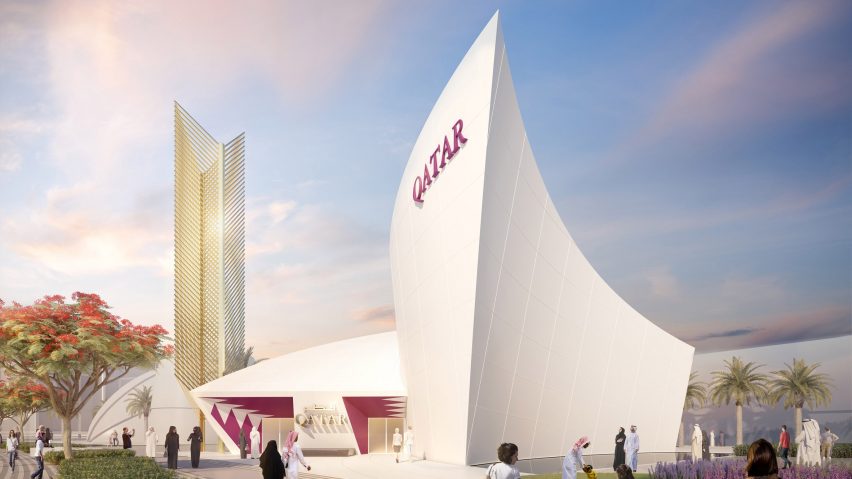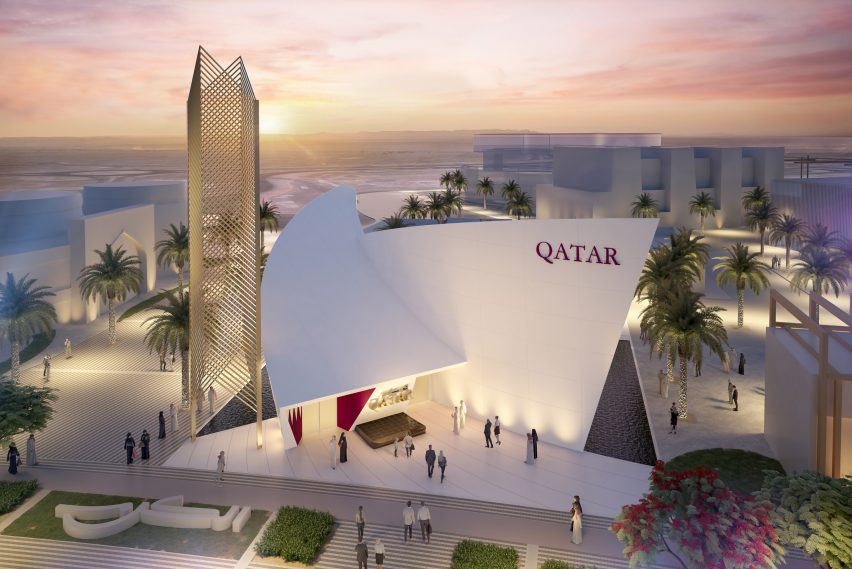
Santiago Calatrava unveils design for Qatar Pavilion at Dubai Expo
Spanish architect Santiago Calatrava has revealed his design for the Qatar Pavilion at the upcoming Expo 2020 Dubai, which draws on the four elements represented on Qatar's coat of arms.
Calatrava's design for the pavilion aimed to translate the two crossed and curved swords, traditional dhow boat and an island with palm trees on the Qatari coat of arms into a building design that would capture "movement, mobility, strength and tradition".
A visualisation of the resulting pavilion shows a curved, sail-shaped structure intersected by a lower building. The completed pavilion will measure 620 square metres, with the main building reaching a height of nearly 15 metres.
The pavilion will contain two main galleries and exhibition spaces showcasing an immersive experience of Qatar's history and culture.
A gold-coloured sculpture representing palm trees will rise to a height of 20 metres next to the pavilion.
Building designed to capture "vision of the nation"
The shape of the pavilion, which is currently being constructed by Dubai contractor ALEC Fitout, was designed to symbolise "Qatar's progressive outlook of the future while remaining true to its culture and heritage".
"Inspiration is derived from Qatar’s national emblem to truly capture the essence and vision of the nation," said Calatrava International CEO Micael Calatrava.

"The architectural gesture and structural form of the pavilion, which houses the entire visitor experience, mirrors the shape of the dhow and its grand sails," he added.
"The sculptural monument at the entrance of the pavilion represents an abstract translation and fusion of two intertwined palm trees, while the reflective pools and integrated water features surrounding the pavilion represent the Arabian Gulf which encompasses the nation of Qatar."
The pavilion is made from KRION, a material that consists of two-thirds natural minerals and a percentage of high-resistance resins.
"It is an ecological material, as it is 100 per cent recyclable," the studio told Dezeen.
Qatar Pavilion to be constructed in five months
The completed building will be shown at the coronavirus-delayed Expo 2020 Dubai, which was postponed from October 2020 until October 2021.
The building, which will be located in the sustainability district of Expo 2020 Dubai, will open on 1 October as the Expo launches.
"The approach follows a non-linear, non-traditional design methodology ensuring project delivery in a very aggressive timeline of five months," the studio said.
"The Qatar Pavilion is designed as a sustainable and functional structure, utilizing efficient processes which enable procurement and construction to proceed as the design develops," it added.
A number of pavilion designs have already been unveiled ahead of the Expo, including main pavilions by Adrian Smith + Gordon Gill, Grimshaw and Foster + Partners. With the Expo originally slated to take place in 2020, many of the buildings on site are largely complete already.
Calatrava has also designed the pavilion for host nation United Arab Emirates, which was modelled on a bird's wings.
Images courtesy of Calatrava.
Expo 2020 Dubai will run from 1 October 2021 – 31 March 2022. See Dezeen Events Guide for an up-to-date list of architecture and design events taking place around the world.